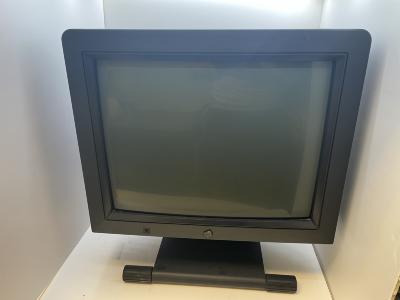NeXT MegaPixel Display
physical object
Identifier
2025.13.10Description
MegaPixal Display, 2-channel digital audio.Origins
In 1985, Apple co-founder Steve Jobs led Apple's SuperMicro division, which was responsible for the development of the Macintosh and Lisa personal computers. Jobs visited university departments and faculty members to sell Macintosh when it was suggested to him that he develop a high-end workstation designed for colleges, students, and universities.
Jobs was intrigued by the concept of a powerful workstation and contemplated starting a higher education computer company in the fall of 1985, amidst increasing turmoil at Apple. Jobs's division failed to release upgraded versions of the Macintosh or much of the Macintosh Office system. As a result, sales plummeted, and Apple was forced to write off millions of dollars in unsold inventory. Apple's chief executive officer (CEO) John Sculley ousted Jobs from his day-to-day role at Apple, replacing him with Jean-Louis Gassée in 1985. Later that year, Jobs began a power struggle to regain control of the company.
After several months of being sidelined, Jobs resigned from Apple on September 13, 1985. He told the board he was leaving to set up a new computer company, and that he would be taking several Apple employees from the SuperMicro division with him. Ten days later, Apple filed a $5 million law suit against Steve Jobs and co-founder Richard Page, to prohibit them from using proprietary Apple information, and from raiding other executives for the purpose of gaining access to Apple information. On January 17, 1986, the suit was dismissed "without prejudice", which meant that the lawsuit could be reinstated if Apple felt that Jobs violated the agreement, or if NeXT's products were found to incorporate proprietary information.
Jobs agreed to not compete with Apple products.
NeXT Computers
Unencumbered by the previous legal issues, Jobs set-out to design, build, and market an entirely new computer system with unique hardware and software. The first NeXT computer was introduced in 1988 at a price of US$6,500 (equivalent to $14,100 in 2019) far above the original target price of $3000.
Features of the NeXT, which had been called a power user's dream, included:
o the first commercially available read/write magneto-optical drive for data storage
o multimedia e-mail
o up to 16MB on-board RAM memory
o built-in "thin-net" ethernet networking
o internal and external SCSI connections
o stereo, CD quality sound, thanks to the built-in DSP
o a giant 17-inch monochrome monitor with 1120 x 832 resolution
o NeXTSTEP was the first OS to featured object-oriented programming, and Display PostScript for true WYSIWYG.
Apple’s sales had begun to decline in the early 1990s but was still far better off than NeXT whose total sales only amounted to 50,000 systems since 1988. In comparison, Apple sold 50,000 Macintosh computers every 73 days.
In February of 1993 NeXT stops manufacturing hardware, in order to save money and focuses on porting the NeXTSTEP operating system to Intel Corp.'s 486 computer chip, which runs Microsoft Windows-based computers. NeXT’s object-oriented, multitasking, UNIX-based operating system, NeXTSTEP, proved to be far ahead of what most companies offered at the time. Although not yet ready for prime time, a reconfigured “OpenStep” version of the OS eventually sold Apple on buying NeXT. Apple Computer, after its own efforts to upgrade the Macintosh operating system failed in December 1996 buys NeXT for $400 million.
After the sale, Steve Jobs first began working as an advisor but was later appointed acting-CEO, and then finally CEO of the company. OpenStep becomes the basis for Apple’s new Mac OS X Server 1.0 operating system in 1999 which is morphed into Mac OS X in 2001.
